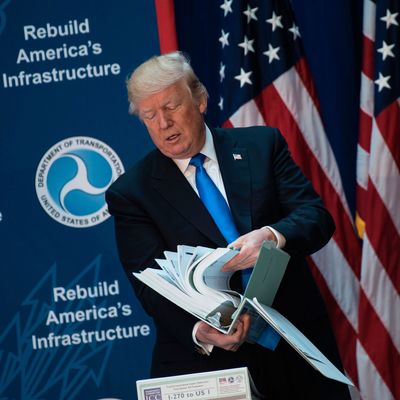
Earlier this week, Donald Trump released a plan to modestly reduce federal infrastructure spending. He, and much of the media, presented it as a “$1.5 trillion” infrastructure stimulus. As with most Trump products, the discrepancy between the plan’s branding and its substance was built on shameless lies.
The official White House plan calls for $200 billion in new infrastructure spending. The president marketed it as a $1.5 trillion plan based on the absurd premise that every dollar Uncle Sam spends on our nation’s “crumbling roads and bridges” will generate $6.50 in additional infrastructure investment from the private sector, states, and municipalities (even though the latter two entities face far-tougher fiscal constraints than the federal government does). The administration has never explained how it arrived at that ratio.
As of late last year, the White House was arguing that $200 billion in federal spending would generate (only) $1 trillion in total infrastructure investment. But “after meeting with mayors and state officials,” administration members told the New York Times, “they concluded that a larger package than Mr. Trump had initially proposed was necessary and feasible.” So, they revised their estimate of how much magic money $200 billion in federal funds would generate.
But the administration isn’t merely overhyping a modest infrastructure bill. Trump’s proposal stipulates that his infrastructure investments would be fully paid for by cuts to other government programs and departments. And while those cuts aren’t specified in the president’s infrastructure blueprint, they are in the official White House budget that Trump also released this week.
In that document, the president calls for financing his new plan by cutting $178 billion, over ten years, from other federal transportation spending. Elsewhere, the White House proposes cuts to spending on water systems and a variety of other infrastructure programs. And when one subtracts all the infrastructure funding Trump is cutting — from all the new infrastructure spending he’s proposing — you end up with a negative $40 billion infrastructure plan.
Now, one could reasonably argue that the president’s budget is just for show — after all, everyone knows Congress will never pass anything like the recipe for dystopia that Mick Mulvaney just cooked up. But then, you could say much the same about Trump’s infrastructure plan, even when taken in isolation.
The bill would effectively transfer infrastructure resources from urban areas to rural ones, while reducing environmental regulations, giving tax breaks to wealthy developers, and trimming social spending. Even if the president had copied the Democratic Party’s official infrastructure proposal verbatim, Chuck Schumer’s caucus might be reluctant to vote for it. The Donkey Party has a shot at winning a wave election this November, and, thus, has little incentive to help Trump pass any piece of major legislation before then — let alone one that antagonizes the Democratic base.
It would be easy (and not exactly unfair) to blame Trump for his plan’s inadequacies. But the primary obstacle to a real infrastructure bill isn’t the president — it’s his party. As this latest dispatch from Axios makes clear:
President Trump endorsed a 25-cent gas tax hike to pay for infrastructure at a White House meeting this morning with senior administration officials and members of Congress from both parties, according to two sources with direct knowledge. Trump also said he was open to other ways to pay for infrastructure, according to a source with direct knowledge.
Reality check: Trump’s gas tax idea appears dead on arrival. Republicans aren’t about to hike taxes for the Trump voters driving their pickup trucks to work every day. It’s a regressive tax and in Republicans’ minds would undo some of working and middle class tax cuts they just passed.
There is overwhelming public support for renovating America’s infrastructure. A pledge to do so was a core part of Trump’s campaign. And everything in the president’s biography suggests that he’s perfectly comfortable sacrificing fiscal discipline for the sake of investing in new construction.
But he can’t — because congressional Republicans won’t let him (and/or he’s far too lazy and out of his depth to fight them on the details of fiscal policy). The GOP’s governing philosophy makes it virtually impossible for the state to maintain its infrastructure (or, in the long run, to fulfill any of its most basic functions). Republicans are committed to perpetually lowering taxes on the rich and perpetually increasing spending on the Pentagon. The party can’t make those commitments fiscally sustainable without gutting Medicare and Social Security; and it has (ostensibly) decided that it can’t gut those programs and expect to win elections. Tax cuts for the rich funded by deficit spending are unpopular — but ones funded by slashing Grandma’s Social Security check are an invitation to guillotines.
This would all be fine if the GOP’s deficit nihilism knew no bounds. But it does. Republicans were willing to spend whatever was necessary to ensure that their allies in corporate America and the military-industrial complex got their due. Now that their donors are taken care of, however, they are ready to pretend that the national debt is an emergency again.
Thus, we can’t put infrastructure on the same credit card we used for the Trump tax cuts. And we can’t raise the gas tax, or any other tax, to keep America’s highways paved — even though the gas tax hasn’t been raised since 1993, and a combination of inflation and advances in fuel efficiency are starving our roadways of the resources they need to survive. We can only pay to maintain our highways by taking food, housing, and medicine away from America’s poor — and it’s not clear that a majority of congressional Republicans actually have the stomach to do even that.
So, despite America’s weekly train crashes, routine bridge failures, and occasional mass poisonings of disadvantaged young people, Washington will do nothing significant to improve our nation’s infrastructure this year.






























